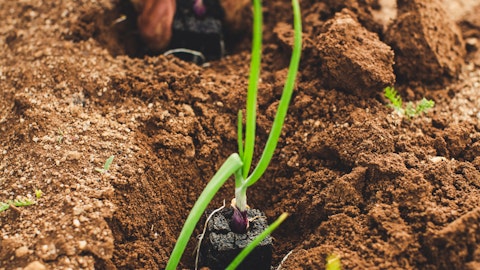Carlos Diaz: Good morning. I’m Carlos Diaz, I’m Executive Vice President of the business, Lithium. Well, as you know, we’re expanding our capacity here in Chile in the lithium carbonate as lithium hydroxide. At the same time, we expect to reach a total capacity next year of lithium hydroxide of 40,000 and 180,000 in lithium carbonate. At the same time, we are expanding our — buying a new capacity of refining and conversion in China at a total of 30,000 for next year, and the same time, working on building a new plant in Australia that will be ready in the year 2024. Additional, what we announced yesterday is to continue expanding our lithium hydroxide capacity in Chile up to reach 100,000 in the year 2025. That is our plan.
And you asked about to do with something in the US. Obviously, we are studying different alternatives that could be one to put a plant in the US or another market that we know that are growing fast for the consumption of lithium for batteries. So, it’s in our scope, but we’re still under study.
P.J. Juvekar: Okay. Thank you. And then I have a question on potash. Brazil is your biggest market. Can you talk about inventories in Brazil that some people think are high? Some people think they have come down in potash. And you talked about higher prices causing some demand weakness. Given that happened in 2022, what’s your outlook for 2023?
Pablo Altimiras: Okay. Pablo Altimiras speaking. Good morning. Well, as you know, I would say that the whole fertilizer industry has been a very unusual year, and demand is not only — the reduction in demand is not only explained because of the price of fertilizer, product. Also, there are a lot of pressure in the farmers’ economies because of the cost of gas, raw materials in general, manpower, et cetera. So of course, that — this have impact in the demand in a very important way. Brazil has not been the exception. And also in Brazil, as you know, they’re starting buying a lot of product at the beginning of the year. So right now, our view is still in that country, we have a lot of inventory, and that explains the low volumes that we saw in this quarter.
Regarding to what will happen, as I said before, still there are a lot of uncertainty. Of course, that we are following up what’s going on with the market situation, so it’s difficult to say. We see some small recoveries now, but I think that because of uncertainty, we need to wait a little bit in order to know what will happen.
P.J. Juvekar: So would you say that demand is weaker in 4Q? I mean, now that Brazil has just finished planting, do you think demand was weaker during the planting season?
Pablo Altimiras: Well, in our specific case, you see that our sales in Q3 were low. We see some recovery in our case. As I said before, because we are starting seeing some sign, as you know, that the demand is getting there. But still, it’s slow because of the level of inventories.
P.J. Juvekar: Okay. Okay, so inventories are high. Okay. Thank you.
Operator: Our next question will come from Jacob Kim with Scotiabank. You may now go ahead.
Jacob Kim: Hi, there. This is Jacob Kim calling in for Ben Isaacson. I just had a couple of questions. Looking at the hydroxide capacity expansion in Chile, you mentioned before that it takes a while to get these expansions up and running, especially in Chile when you have to jump through so many hurdles. Can you talk about whether this is an accelerated process? And if so, has any time line been accelerated for any of your other projects like China, the Salar Futuro?
Ricardo Ramos: Yes. Well, we’re doing as much as fast as we can. You know that we’re already expanding the lithium carbonate capacity in Chile at the same time doing the same with lithium hydroxide to reach 40,000. And after that, immediately, we’ll start with the new expansion announced yesterday. And for the other side, we just received the permit for doing that just a month or a couple of weeks ago, so we’re just now in the moment to start with that. So, we think that we are doing as much as possible, I mean, instead of doing faster. And we have been building and increasing our capacity in the last three or four years, and we will keep doing that for the next two or three years at least.
Jacob Kim: Sounds good. And just one last question. Just in terms of the pricing contracts, I know that you’ve mentioned that there are some long-term pricing contracts in place, and you’ve talked about the pros and cons before of these long-term pricing contracts. Just in general, as they follow general market conditions, is there a strategic point in time that you identify when you would want to lock in the long-term pricing?
Gerardo Illanes: Yes. At the end, today, in our discussions with customers, we are referring to market indexes. We believe that this is the healthiest way to contract our product. So, definitely, locking prices is something that is out of the question for us today. We are following indexes. We believe this is the best.




